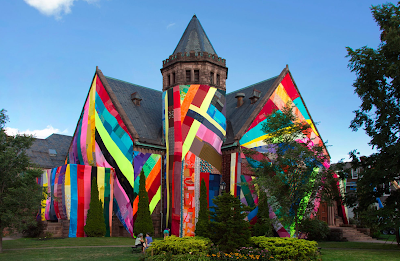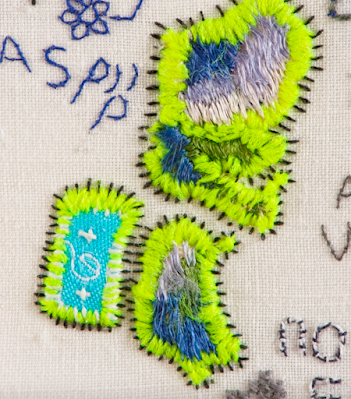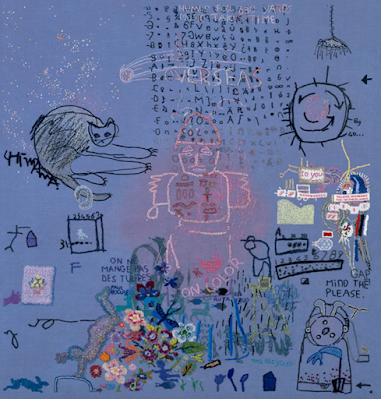Saturday, 10 February 2024
Judith Scott, Artist, American, b.1943, d. 2005
Amanda Browder, Artist
Materials List for Textiles and Natural Dye Class
All students must have
9-inch Fabric Scissors
Thread snips and/or Detail Scissors
FABRIC SCISSORS
Must be scissors specifically made for fabric.
Several brands to choose from.
I recommend 9-inch Fiskars. Can find in craft stores and online.
DETAIL SCISSORS
4 1/2 inch with Nano Tip
The items below are available in the studio for students to share.
For those that want their own supplies, I listed in order of importance below.
SEWING NEEDLES
If you are new to threading needles, large eye holes are easier. You can find in craft stores and online. Two examples below. All needles in the first example have large eyes. I suggest an assortment of needles with various size eye holes, length and sharpness. You will need different needles for different processes.
AN IRON
Does not have to be the model shown below. This is what I have in the studio to share. If you have your own iron at home/dorm, you will not have to wait to use the iron during class time. Irons cannot be used outside of class time.
NYLON UPHOLSTERY THREAD
Sewology available at Hobby Lobby (some stores only available online) 100% extra strong bonded nylon upholstery. Color – White or Chiffon. 150 Yards. Must be 100% bonded nylon. We are using for Shibori stitching.
Coats & Clark Specialty Thread Upholstery 150 YD Natural,Cream/White
STRAIGHT PINS
Available in craft stores and online.
Can also find in grocery store in the aisle with cleaning supplies.
OR
SEAM RIPPER
Can purchase at craft store or online.
Can also purchase single or in a set.
SEWING THREAD FOR HAND STITCHING
Cotton thread snaps easier than a polyester blend. Various thread colors and blends available in the studio. You may want to purchase thread after the first few weeks of class when you have a better idea of your project ideas.
MEASURING TAPE
A few are available in the studio for students to share. If you have your own you will not have to share. Available in craft stores and online. Can also find in grocery store (usually aisle with cleaning supplies).
The items below are not available in the studio or required. However, some of you may want to have these items when we dye.
REUSABLE RUBBER GLOVES
The natural dyes we use may stain your hands. If you choose to use indigo, this dye will stain your hands. Tongs are available for students to retrieve their fabric bundles from the dye pots. However, some students find they want to use gloves. Available at grocery stores and online. If you purchase, write your name on the gloves with a sharpie.
APRON
On the days we dye, I suggest wearing old clothes or an apron.
Available at craft stores or online.
Transporting your materials
and storage in the studio.
There is limited space in the studio to store your materials and projects. If you decide to leave your work or materials in the studio, I have a bit of space available in the large metal textile cabinet.
Need a canvas tote bag about the size of a large laptop if you want to keep your fabric pieces in the textile cabinet in the studio. A flat bottom bag is most efficient for storage in the metal textile cabinet.
Please do not use a plastic bag. Plastic rips easily causing items to disperse and clutter the limited space for student storage. Larger tote bags will not work as the large size will consume the space.
Keep scissors, needle and threads in some sort of plastic case/bin. Use a sharpie to put your name on the case/bin and on all your items. I suggest not leaving your scissors/needles.
I suggest keeping needles in felt so as not to loose or damage. You can purchase a small sheet of felt, approximately 8” x 10”, at craft stores for approximately 50 cents. There are also felt scraps in the studio. Below is an example of a needle felt book. You do not have to make the "book" - can use small pieces of felt. If interested in the making a felt book, a plethora of examples on Pinterest.
Or a magnetic needle carrying case is preferred by some. You can find different sizes online and in craft stores.
Thursday, 8 February 2024
Laura Towne, Student Work
Jordan Assar, Artist
Jordan Nassar’s favored subject is landscape. He embroiders his compositions, which are framed by, and built up through, repeating patterns adapted from traditional Palestinian motifs. At first glance his scenes seem innocuous enough. They comprise rolling hills, rendered sometimes in vibrant shades of red, while other times in more muted grays and browns. These hills are framed by a dramatically hued sky: oftentimes blue, as we might expect, while in other works it is pink or orange. In these the effect is of distant peaks dappled by the rays of a setting late summer sun. This idyll, which initially seems like an abstract anywhere, turns out to be imaginary, yet specific. The artist is of Palestinian descent, but was born and raised in New York City. Extending from this, his work evokes a very particular kind of imagined space: the sort of utopian vision of Palestine held by the displaced constituents that comprise the region’s diaspora.
Elaine Reichek, Artist
The Textile Museum Journal
Wednesday, 7 February 2024
Jennifer Pettus, Artist based in Colorado
Shindig/Wingding
58 x 60 x 12″
Pencil and colored pencil on satin and cotton voile, fabric transfer ink, gold and bronze tulle, cotton thread, synthetic yarn, cotton balls, fabric dye, burlap, perler beads, gold dressing pins, synthetic hair, acrylic paint, sequin trim
Honest or Flare
84 x 20 x 10″
Pencil and colored pencil on tea stained cotton voile, fabric transfer ink, lace, silk flowers, cranberry juice, coffee, hand dyed yarn, duster, faux fur, lace trim, plastic rock, dehydrated apple, ear plug, gold chain
Go to artist website to see more.
http://www.jenniferpettus.com/
Student Blogs, Spring 2025
Clare Cassidy Rhys Conner Gem Hansen Hayley Harris Julia Hewitt Sophia Johnston Laurel Koschal Owen Lindsey Colin Locatell Alaina Medina E...
-
Clare Cassidy Rhys Conner Gem Hansen Hayley Harris Julia Hewitt Sophia Johnston Laurel Koschal Owen Lindsey Colin Locatell Alaina Medina E...
-
To make ink using natural dye powder, mix chosen dye powder with a liquid medium like water, and add a binding agent like gum arabic to he...




















































